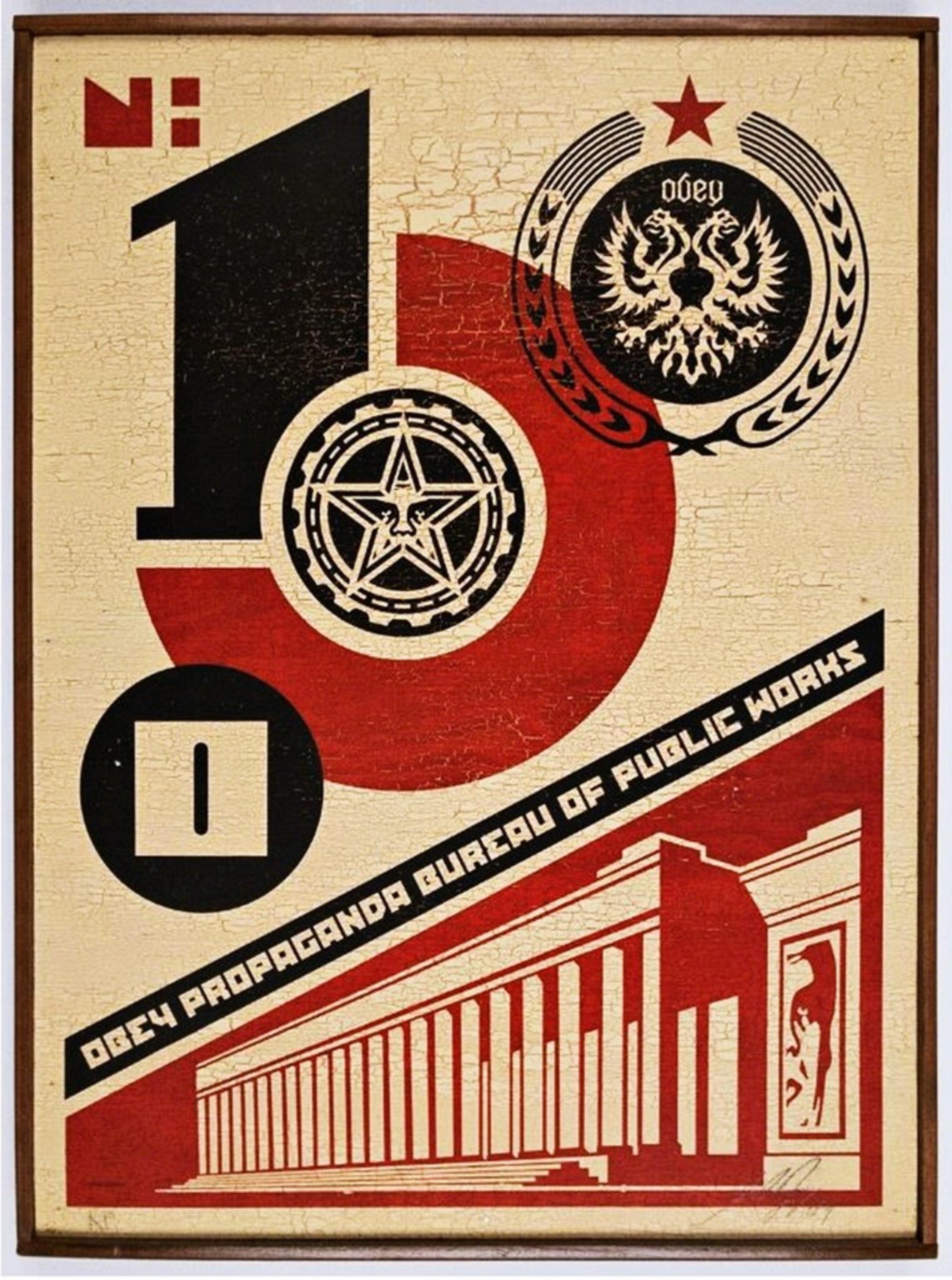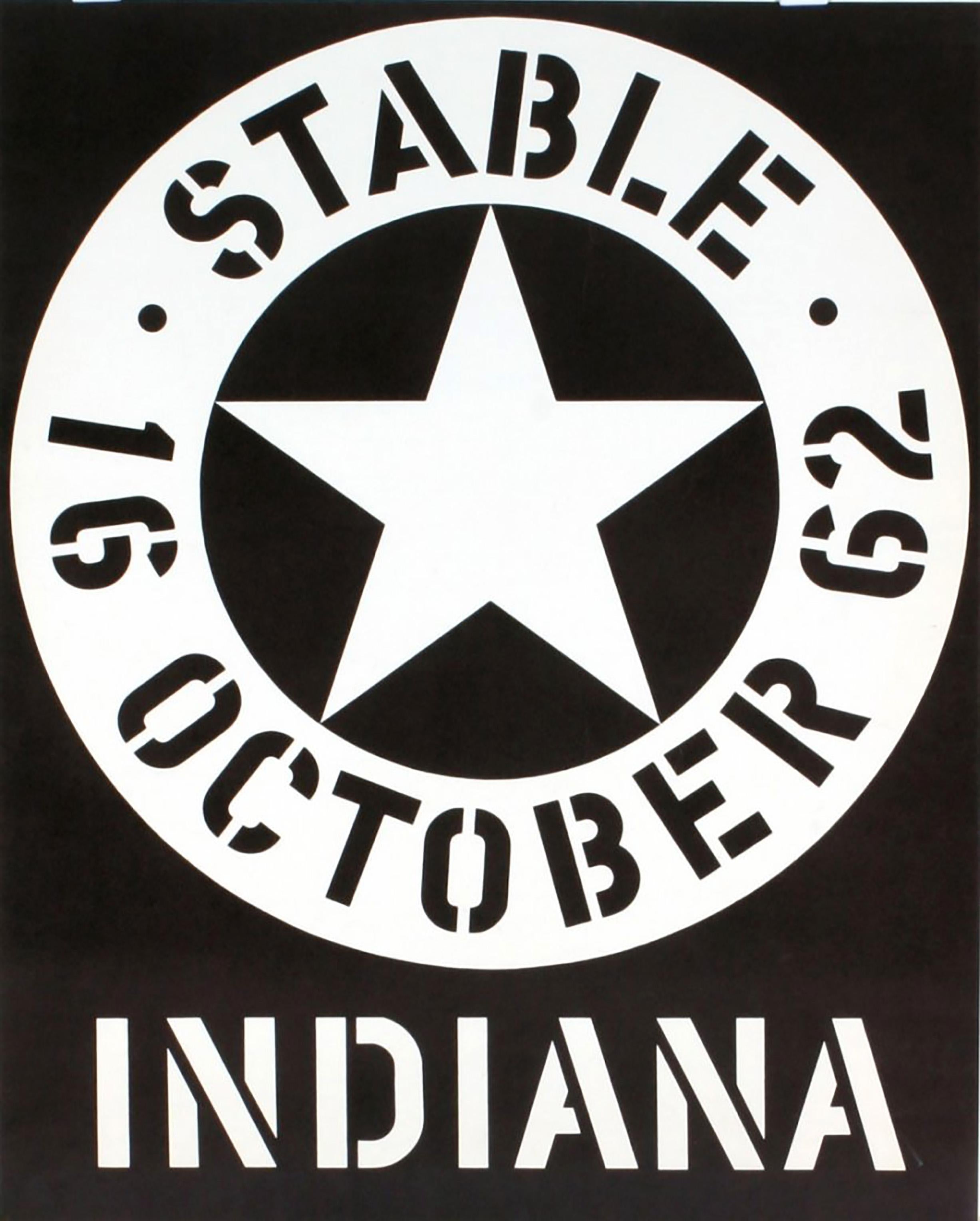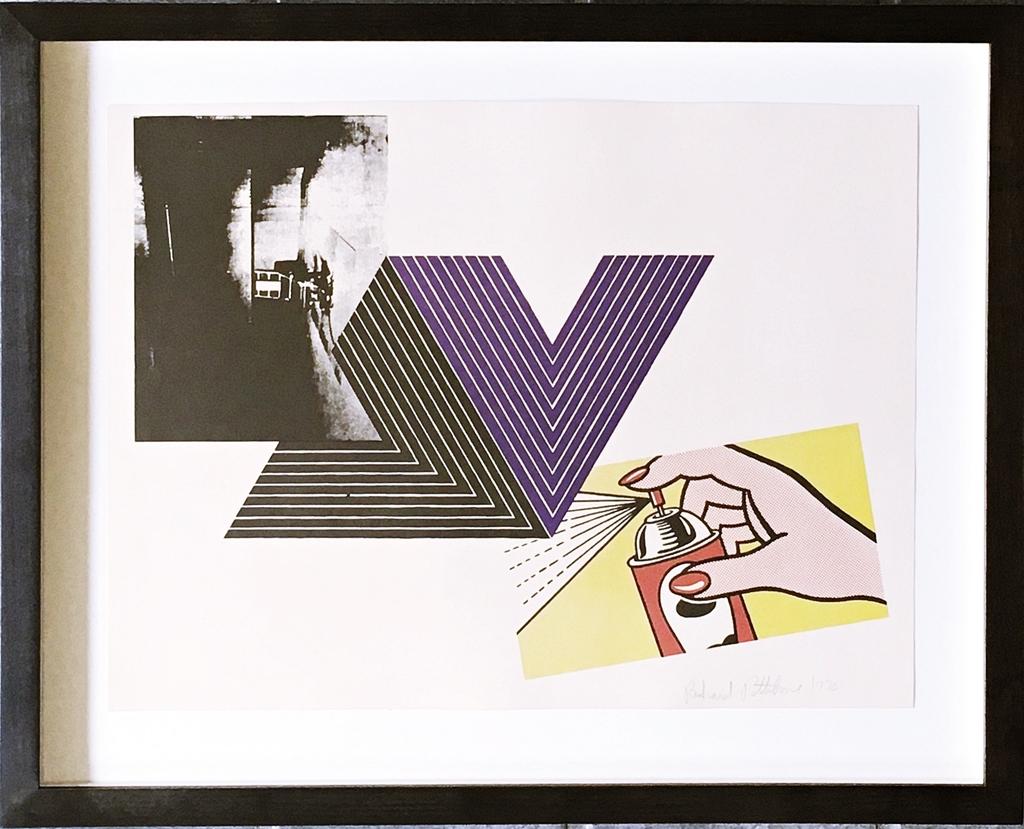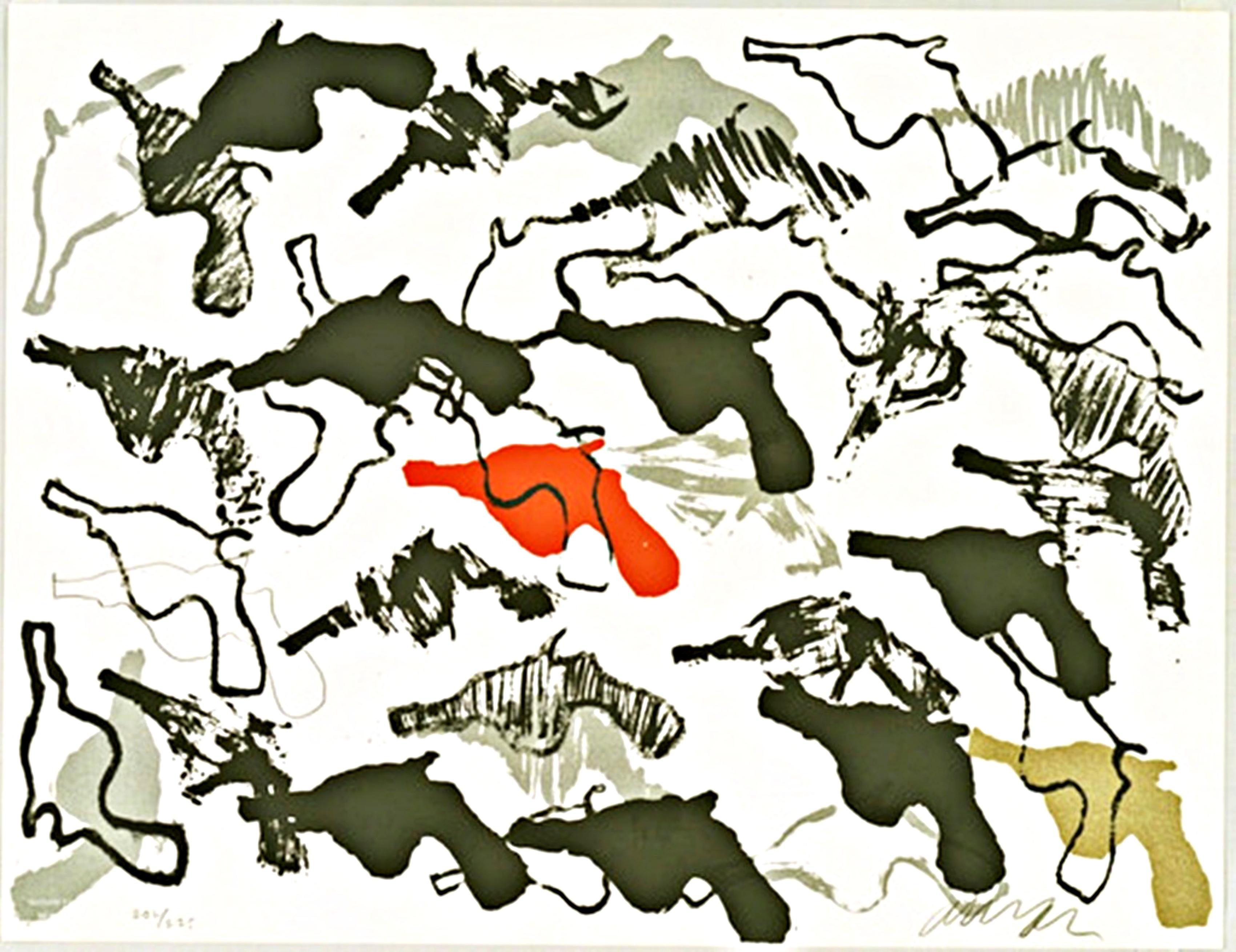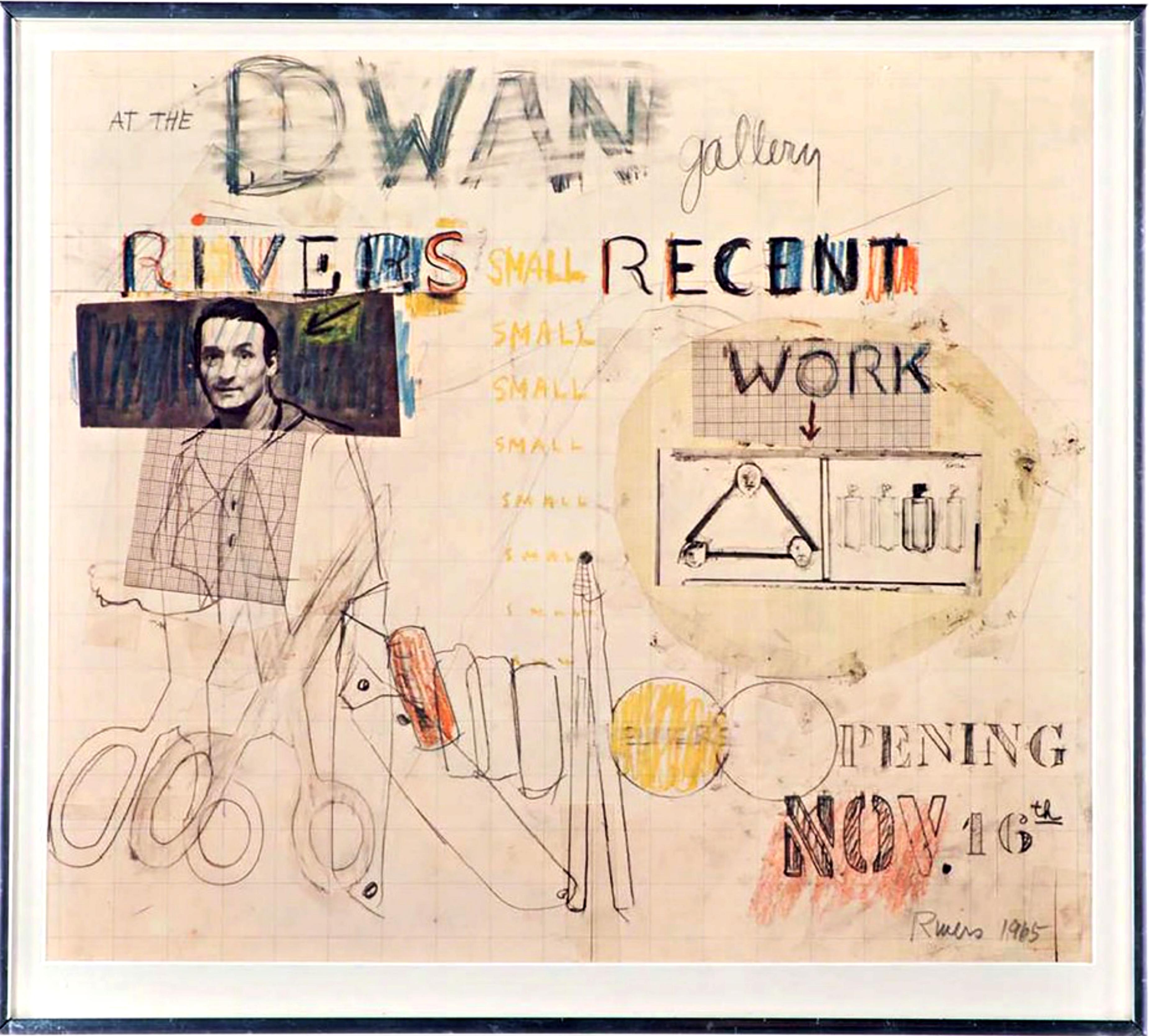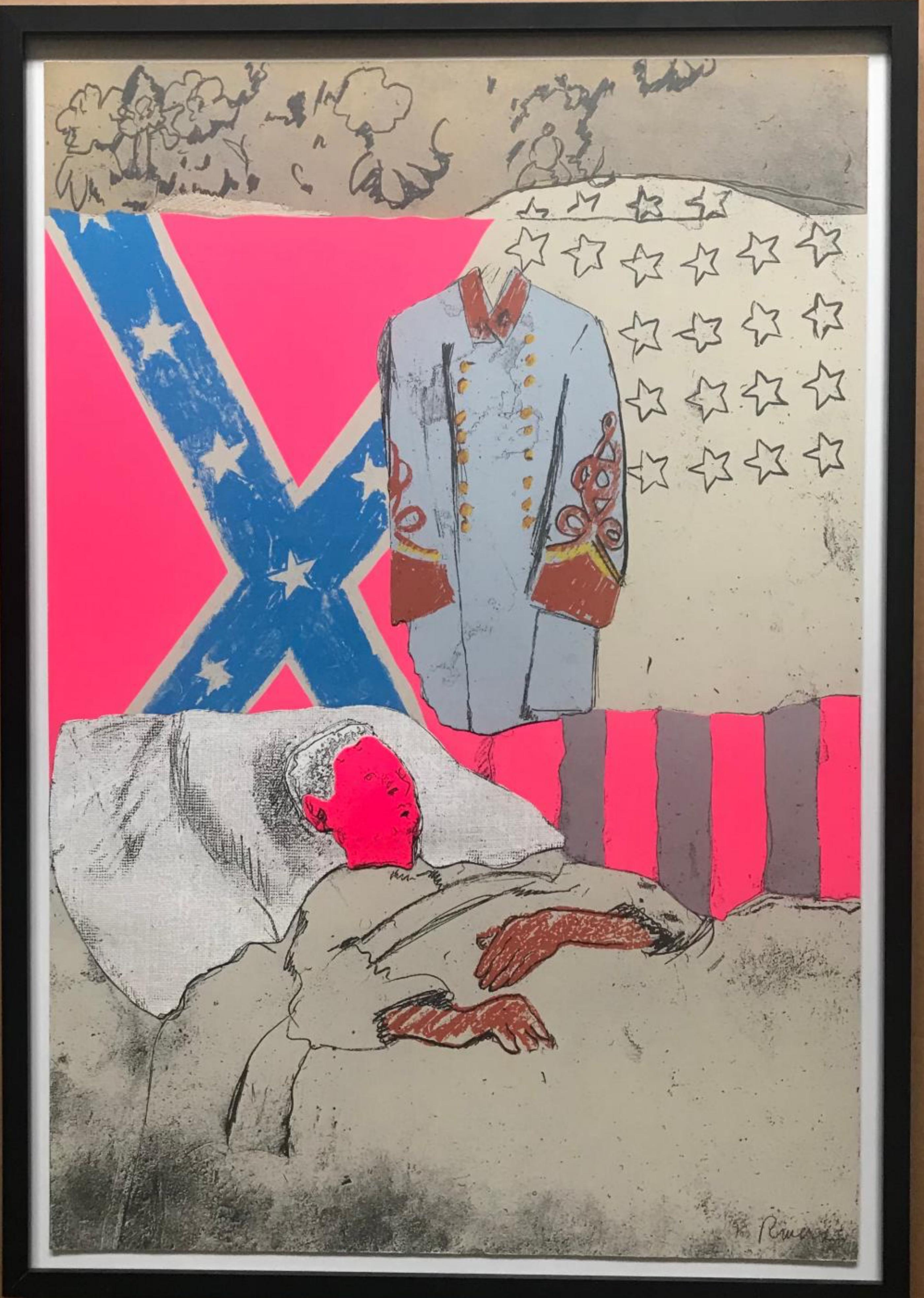Items Similar to Rare Op Art Mid Century Modern Geometric Abstraction 1960s Pop Art Signed 6/9
Want more images or videos?
Request additional images or videos from the seller
1 of 7
John GrilloRare Op Art Mid Century Modern Geometric Abstraction 1960s Pop Art Signed 6/9 1969
1969
About the Item
John Grillo
Untitled Op Art Mid Century Modern, 1969
Color silkscreen on art paper with deckled edges
Signed and dated lower right; numbered 6/9 lower left
Limited Edition of only 9
Unframed
The present work is a dazzling, extremely rare 1960s screenprint by Abstract Expressionist painter John Grillo, who died in 2014 at the age of 97. Hand signed and numbered from a small edition of only 9, it is a fusion of Op Art, Pop and Abstract Expressionist elements, in a vibrant palette anchored in red - a nod to the psychedelic colors of the late 1960s. It is in very good condition with deckled edges
John Grillo Biography
A leading exponent of Bay Area Abstract Expressionism during the 1940s, John Grillo was a painter, sculptor, and printmaker regarded as one the purest and most influential “action painters” on the West Coast. Though his diverse and colorful body of work ranged from abstraction to figuration, his art is considered linked in its uniquely aggressive and spontaneous approach. Grillo creates bold, fluid, gestural works such as Untitled #69 (1947) and Untitled (1949) that draw on the influence of Surrealist automatism. After moving to New York in 1948, Grillo began a series of paintings consisting of small, precisely organized colored squares, as seen in Untitled (1951) and Untitled (1959); these and other works were influenced by the color theories of Hans Hofmann, with whom he studied. Grillo’s later work was more figurative, but no less colorful, with works such as Blue Hat (1978) or Duerme (1980) recalling the Expressionism of Max Beckmann.
- Creator:John Grillo (1917, American)
- Creation Year:1969
- Dimensions:Height: 27.75 in (70.49 cm)Width: 22.5 in (57.15 cm)Depth: 0.1 in (2.54 mm)
- Medium:
- Movement & Style:
- Period:
- Condition:
- Gallery Location:New York, NY
- Reference Number:1stDibs: LU1745212955512
About the Seller
5.0
Platinum Seller
These expertly vetted sellers are 1stDibs' most experienced sellers and are rated highest by our customers.
Established in 2007
1stDibs seller since 2022
306 sales on 1stDibs
Typical response time: 1 hour
- ShippingRetrieving quote...Ships From: New York, NY
- Return PolicyA return for this item may be initiated within 1 day of delivery.
More From This SellerView All
- Bureau of Public Works (Mixed Media on Wood) Twice Signed Artists Proof Ed of 2By Shepard FaireyLocated in New York, NYSHEPARD FAIREY Bureau of Public Works (on Wood), 2004 Mixed media silkscreen on wood panel. Hand signed and annotated on both the recto and verso. In original handmade artist's frame...Category
Early 2000s Pop Art Mixed Media
MaterialsWood, Mixed Media, Screen, Pencil
- Stable Gallery 16 October 1962 hand signed & inscribed by Robert Indiana - RAREBy Robert IndianaLocated in New York, NYRobert Indiana Stable Gallery 16 October 1962 (Hand Signed & Inscribed) Silkscreen on art paper Signed and Dedicated in pencil on the recto. The dedication and signature reads "For...Category
1960s Pop Art Abstract Prints
MaterialsPencil, Screen
- The Pop Art Appropriation Print: Electric Chair, Empress of India, Spray SignedBy Richard PettiboneLocated in New York, NYRichard Pettibone The Appropriation Print: Andy Warhol, Frank Stella, Roy Lichtenstein, 1970 (Andy Warhol's Electric Chair, Frank Stella's Empress of India and Roy Lichtenstein's Spray) Silkscreen in colors on smooth wove paper Pencil signed and dated 1971 on the front Frame included: Elegantly floated and framed in a white wood frame under UV plexiglass in accordance with museum conservation standards Measurements: frame: 15 7/8 x 19 3/4 x 1 3/4 inches sheet: 12 1/4 x 16 inches This is one of Richard Pettibone's most iconic, popular and desirable prints done in 1970 - during the most influential era of the Pop Art movement. This homage to Andy Warhol, Frank Stella and Roy Lichtenstein exemplifies the type of artistic appropriation he was engaging in early on during the height of the Pop Art movement - long before more contemporary artists like Deborah Kass, Louise Lawler, etc. followed suit. Pencil signed and dated recto. It was created in limited edition - though the exact number is not known. More about RIchard Pettibone: As a young painter, Richard Pettibone began replicating on a miniature scale works by newly famous artists, and later also modernist masters, signing the original artist’s name as well as his own. His versions of Andy Warhol’s soup...Category
1970s Pop Art Abstract Prints
MaterialsPencil, Screen
- Boom Boom, mid century print from the New York International portfolio S/N 1960sBy ArmanLocated in New York, NYArman Boom Boom (unique variation from New York International Portfolio), 1965 Screenprint with pencil additions. Pencil signed and numbered 12/225 on the front Published by Chiron ...Category
1960s Pop Art Abstract Prints
MaterialsScreen, Pencil, Graphite
- At The Dwan Gallery: Historic exhibition poster (Hand Signed by Larry Rivers)By Larry RiversLocated in New York, NYLarry Rivers At The Dwan Gallery: Rivers Small Recent Work (Hand Signed), 1965 Silkscreen on wove paper Hand signed and dated "Rivers, 1965" in graphite p...Category
1960s Pop Art Abstract Prints
MaterialsScreen, Pencil
- The Last Civil War Veteran limited edition signed mixed media silkscreen collageBy Larry RiversLocated in New York, NYLarry Rivers The Last Civil War Veteran, 1970 Silkscreen and mixed media collage on paper 29 × 19 3/4 inches Frame included Hand signed and numbered 55/100 in graphite pencil lower front 1970 Mixed media collage multiple based upon famous Larry Rivers 1961 painting "The Last Civil War Veteran'. (In 1979-80, Rivers reprised this theme with another edition of 125, but this is the original 1970 print from the limited edition of only 100) In 1962, the Museum of Modern Art acquired The Last Civil War Veteran and by early 1963 put it on view. 1963 marked the hundred-year anniversary of the Emancipation Proclamation...Category
1970s Pop Art Abstract Prints
MaterialsMixed Media, Screen, Laid Paper, Pencil, Graphite
You May Also Like
- PurimBy Larry RiversLocated in New York, NYA very good impression of this scarce, early color lithograph with additions in pencil and crayon on Auvergne à la main (Richard de bas) ivory laid paper. Signed, dated and numbered 15/45 in pencil, lower margin. Printed by Robert Blackburn...Category
1960s Pop Art Abstract Prints
MaterialsCrayon, Pencil, Color, Lithograph
- The Hartley Elegies - KvF X, Pop Art Silkscreen by Robert IndianaBy Robert IndianaLocated in Long Island City, NYArtist: Robert Indiana Title: The Hartley Elegies - KvF X Year: 1991 Medium: Screenprint, signed and numbered in pencil Edition: 50 Paper Size: 60 x 60 inches Printer: Bob Blanto...Category
1990s Pop Art Abstract Prints
MaterialsScreen
- "God is Lily of the Valley", from the American Dream Portfolio by Robert IndianaBy Robert IndianaLocated in Long Island City, NYArtist: Robert Indiana, American (1928 - 2018) Title: God is a Lily of the Valley from the American Dream Portfolio Year: 1961-62 (1997) Medium: Serigraph Edition: 395 Image Size: 16...Category
1990s Pop Art Abstract Prints
MaterialsScreen
- 1970's Large Silkscreen Abstract Geometric Day Glo Serigraph Pop Art Print NeonBy Chryssa Vardea-MavromichaliLocated in Surfside, FLSilkscreen on Arches paper, Hand signed and Numbered in Pencil. Serigraph in blue gray (silver). Chryssa Vardea-Mavromichali (Greek: Χρύσα Βαρδέα-Μαυρομιχάλη; December 31, 1933 – December 23, 2013) was a Greek American artist who worked in a wide variety of media. An American art pioneer in light art and luminist sculpture widely known for her neon, steel, aluminum and acrylic glass installations, she has always used the mononym Chryssa professionally. She worked from the mid-1950s in New York City studios and worked since 1992 in the studio she established in Neos Kosmos, Athens, Greece. Chryssa was born in Athens into the famous Mavromichalis family from the Mani Peninsula. one of her sisters, who studied medicine, was a friend of the poet and novelist Nikos Kazantzakis. Chryssa began painting during her teenage years and also studied to be a social worker.In 1953, on the advice of a Greek art critic, her family sent her to Paris to study at the Académie de la Grande Chaumiere where Andre Breton, Edgard Varese, and Max Ernst were among her associates and Alberto Giacometti was a visiting professor. In 1954, at age twenty-one, Chryssa sailed for the United States, arrived in New York and went to San Francisco, California to study at the California School of Fine Arts. Returning to New York in 1955, she became a United States citizen and established a studio in the city. Chryssa's first major work was The Cycladic Books preceded American minimalism by seventeen years. 1961, Chryssa's first solo exhibition was mounted at The Guggenheim. 1963, Chryssa's work was shown at the Museum of Modern Art in curator Dorothy Canning Miller's Americans 1963 exhibition. The artists represented in the show also included Richard Anuszkiewicz, Lee Bontecou, Robert Indiana, Richard Lindner, Marisol, Claes Oldenburg, Ad Reinhardt, James Rosenquist and others. 1966, The Gates to Times Square, regarded as "one of the most important American sculptures of all time" and "a thrilling homage to the living American culture of advertising and mass communications." The work is a 10 ft cube installation of two huge letter 'A's through which visitors may walk into "a gleaming block of stainless steel and Plexiglas that seems to quiver in the play of pale blue neon light" which is controlled by programmed timers. First shown in Manhattan's Pace Gallery, it was given to the Albright-Knox Art Gallery in Buffalo, New York in 1972. 1972, The Whitney Museum of American Art mounted a solo exhibition of works by Chryssa. That's All (early 1970s), the central panel of a triptych related to The Gates of Times Square, was acquired by the Museum of Modern Art between 1975 and 1979. 1973, Chryssa's solo exhibition at the Gallerie Denise René was reviewed for TIME magazine by art critic Robert Hughes before it went on to the Galleries Denise René in Düsseldorf and Paris. Other works by Chryssa in composite honeycomb aluminum and neon in the 1980s and 1990s include Chinatown, Siren, Urban Traffic, and Flapping Birds. Chryssa 60/90 retrospective exhibition in Athens in the Mihalarias Art Center. After her long absence from Greece, a major exhibition including large aluminum sculptures - cityscapes, "neon boxes" from the Gates to the Times Square, paintings, drawings etc. was held in Athens. In 1992, after closing her SoHo studio, which art dealer Leo Castelli had described as "one of the loveliest in the world," Chryssa returned to Greece. She found a derelict cinema which had become a storeroom stacked with abandoned school desks and chairs, behind the old Fix Brewery near the city center in Neos Kosmos, Athens. Using the desks to construct enormous benches, she converted the space into a studio for working on designs and aluminum composite honeycomb sculptures...Category
1980s Pop Art Abstract Prints
MaterialsScreen
- 1970's Large Silkscreen Abstract Geometric Day Glo Serigraph Pop Art Print NeonBy Chryssa Vardea-MavromichaliLocated in Surfside, FLSilkscreen on Arches paper, Hand signed and Numbered in Pencil. Serigraph in white, back, blue gray (silver). Chryssa Vardea-Mavromichali (Greek: Χρύσα Βαρδέα-Μαυρομιχάλη; December 31, 1933 – December 23, 2013) was a Greek American artist who worked in a wide variety of media. An American art pioneer in light art and luminist sculpture widely known for her neon, steel, aluminum and acrylic glass installations, she has always used the mononym Chryssa professionally. She worked from the mid-1950s in New York City studios and worked since 1992 in the studio she established in Neos Kosmos, Athens, Greece. Chryssa was born in Athens into the famous Mavromichalis family from the Mani Peninsula. one of her sisters, who studied medicine, was a friend of the poet and novelist Nikos Kazantzakis. Chryssa began painting during her teenage years and also studied to be a social worker.In 1953, on the advice of a Greek art critic, her family sent her to Paris to study at the Académie de la Grande Chaumiere where Andre Breton, Edgard Varese, and Max Ernst were among her associates and Alberto Giacometti was a visiting professor. In 1954, at age twenty-one, Chryssa sailed for the United States, arrived in New York and went to San Francisco, California to study at the California School of Fine Arts. Returning to New York in 1955, she became a United States citizen and established a studio in the city. Chryssa's first major work was The Cycladic Books preceded American minimalism by seventeen years. 1961, Chryssa's first solo exhibition was mounted at The Guggenheim. 1963, Chryssa's work was shown at the Museum of Modern Art in curator Dorothy Canning Miller's Americans 1963 exhibition. The artists represented in the show also included Richard Anuszkiewicz, Lee Bontecou, Robert Indiana, Richard Lindner, Marisol, Claes Oldenburg, Ad Reinhardt, James Rosenquist and others. 1966, The Gates to Times Square, regarded as "one of the most important American sculptures of all time" and "a thrilling homage to the living American culture of advertising and mass communications." The work is a 10 ft cube installation of two huge letter 'A's through which visitors may walk into "a gleaming block of stainless steel and Plexiglas that seems to quiver in the play of pale blue neon light" which is controlled by programmed timers. First shown in Manhattan's Pace Gallery, it was given to the Albright-Knox Art Gallery in Buffalo, New York in 1972. 1972, The Whitney Museum of American Art mounted a solo exhibition of works by Chryssa. That's All (early 1970s), the central panel of a triptych related to The Gates of Times Square, was acquired by the Museum of Modern Art between 1975 and 1979. 1973, Chryssa's solo exhibition at the Gallerie Denise René was reviewed for TIME magazine by art critic Robert Hughes before it went on to the Galleries Denise René in Düsseldorf and Paris. Other works by Chryssa in composite honeycomb aluminum and neon in the 1980s and 1990s include Chinatown, Siren, Urban Traffic, and Flapping Birds. Chryssa 60/90 retrospective exhibition in Athens in the Mihalarias Art Center. After her long absence from Greece, a major exhibition including large aluminum sculptures - cityscapes, "neon boxes" from the Gates to the Times Square, paintings, drawings etc. was held in Athens. In 1992, after closing her SoHo studio, which art dealer Leo Castelli had described as "one of the loveliest in the world," Chryssa returned to Greece. She found a derelict cinema which had become a storeroom stacked with abandoned school desks and chairs, behind the old Fix Brewery near the city center in Neos Kosmos, Athens. Using the desks to construct enormous benches, she converted the space into a studio for working on designs and aluminum composite honeycomb sculptures...Category
1980s Pop Art Abstract Prints
MaterialsScreen
- 1970's Large Silkscreen Abstract Geometric Day Glo Serigraph Pop Art Print NeonBy Chryssa Vardea-MavromichaliLocated in Surfside, FLSilkscreen on Arches paper, Hand signed and Numbered in Pencil. Serigraph in black, gray (silver). Chryssa Vardea-Mavromichali (Greek: Χρύσα Βαρδέα-Μαυρομιχάλη; December 31, 1933 – December 23, 2013) was a Greek American artist who worked in a wide variety of media. An American art pioneer in light art and luminist sculpture widely known for her neon, steel, aluminum and acrylic glass installations, she has always used the mononym Chryssa professionally. She worked from the mid-1950s in New York City studios and worked since 1992 in the studio she established in Neos Kosmos, Athens, Greece. Chryssa was born in Athens into the famous Mavromichalis family from the Mani Peninsula. one of her sisters, who studied medicine, was a friend of the poet and novelist Nikos Kazantzakis. Chryssa began painting during her teenage years and also studied to be a social worker.In 1953, on the advice of a Greek art critic, her family sent her to Paris to study at the Académie de la Grande Chaumiere where Andre Breton, Edgard Varese, and Max Ernst were among her associates and Alberto Giacometti was a visiting professor. In 1954, at age twenty-one, Chryssa sailed for the United States, arrived in New York and went to San Francisco, California to study at the California School of Fine Arts. Returning to New York in 1955, she became a United States citizen and established a studio in the city. Chryssa's first major work was The Cycladic Books preceded American minimalism by seventeen years. 1961, Chryssa's first solo exhibition was mounted at The Guggenheim. 1963, Chryssa's work was shown at the Museum of Modern Art in curator Dorothy Canning Miller's Americans 1963 exhibition. The artists represented in the show also included Richard Anuszkiewicz, Lee Bontecou, Robert Indiana, Richard Lindner, Marisol, Claes Oldenburg, Ad Reinhardt, James Rosenquist and others. 1966, The Gates to Times Square, regarded as "one of the most important American sculptures of all time" and "a thrilling homage to the living American culture of advertising and mass communications." The work is a 10 ft cube installation of two huge letter 'A's through which visitors may walk into "a gleaming block of stainless steel and Plexiglas that seems to quiver in the play of pale blue neon light" which is controlled by programmed timers. First shown in Manhattan's Pace Gallery, it was given to the Albright-Knox Art Gallery in Buffalo, New York in 1972. 1972, The Whitney Museum of American Art mounted a solo exhibition of works by Chryssa. That's All (early 1970s), the central panel of a triptych related to The Gates of Times Square, was acquired by the Museum of Modern Art between 1975 and 1979. 1973, Chryssa's solo exhibition at the Gallerie Denise René was reviewed for TIME magazine by art critic Robert Hughes before it went on to the Galleries Denise René in Düsseldorf and Paris. Other works by Chryssa in composite honeycomb aluminum and neon in the 1980s and 1990s include Chinatown, Siren, Urban Traffic, and Flapping Birds. Chryssa 60/90 retrospective exhibition in Athens in the Mihalarias Art Center. After her long absence from Greece, a major exhibition including large aluminum sculptures - cityscapes, "neon boxes" from the Gates to the Times Square, paintings, drawings etc. was held in Athens. In 1992, after closing her SoHo studio, which art dealer Leo Castelli had described as "one of the loveliest in the world," Chryssa returned to Greece. She found a derelict cinema which had become a storeroom stacked with abandoned school desks and chairs, behind the old Fix Brewery near the city center in Neos Kosmos, Athens. Using the desks to construct enormous benches, she converted the space into a studio for working on designs and aluminum composite honeycomb sculptures...Category
1980s Pop Art Abstract Prints
MaterialsScreen
Recently Viewed
View AllMore Ways To Browse
1960s Modern Art
Red Mid Century Art
1960s Geometric Art
Midcentury Pop Art
Vintage Blue Hat
Vintage Anchor Art
Midcentury Pop Prints
Midcentury Modern Op Art
Vintage Painters Hat
Midcentury Screen Geometric
1960s Psychedelic
Midcentury Silkscreens
Retro Psychedelic Pop Art
1960s Dior Hat
John Grillo On Sale
Vintage Lighted Advertising Sign
Max Ernst Signed Lithograph
German Light Tokyo
